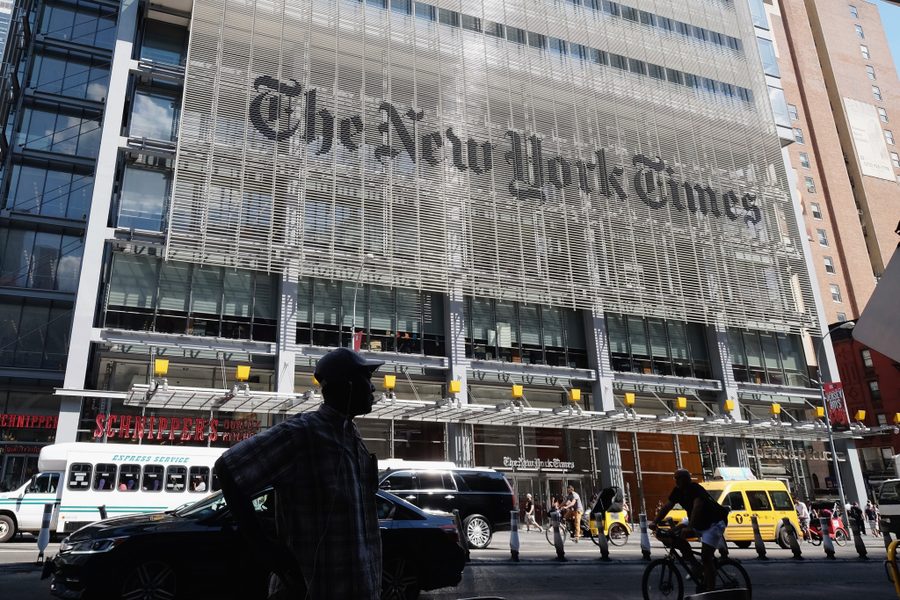Shrugging Off Anti-Union Campaign, New York Times Tech Workers See a Chance to Make History
Times workers plan to ride the media union wave right onto a bigger wave of tech organizing.
Hamilton Nolan

In April, more than 650 tech workers at the New York Times announced that they were unionizing with the NewsGuild, forming what would instantly become one of the biggest unions of tech workers in America. Times management refused to voluntarily recognize the union, a break that could be a harbinger of more hostile labor relations throughout the media industry. But the tech workers remain supremely confident that they will prevail — and they are already contemplating the start of a much bigger union wave in the broader tech industry.
For the past six years, newsrooms have been unionizing at a rapid clip, making the media one of the labor movement’s bright spots. Most of those unions, though, consist solely of journalists and other workers on the editorial side of publications. It has not gone unnoticed that everywhere that has a media union also has a large group of tech workers who could potentially be organized as well. For unions, tech-side employees of media companies represent both an obvious way into the mostly non-union tech industry, and a chance to further consolidate power for workers inside of companies that are already partly unionized. In this context, the NYT Tech Guild marks an important strategic step for the labor movement in two powerful industries.
Organizing among Times tech workers began about two years ago, according to Goran Svorcan, a senior software engineer who was involved from its early stages. The pandemic delayed the effort, but the work continued with help from organizers at the NewsGuild, which has long represented the Times newsroom. Svorcan had never been in a union before, but says that it seemed like the “logical next step” in addressing employee concerns. Contrary to common stereotypes about why tech workers and engineers have not widely organized (because they are too libertarian-minded, or because they are an individualistic culture), Svorcan believes that unions are in line with the public-minded ideals of early internet pioneers — ideals that faded as the industry became rich and powerful. “It’s kind of a proto-organizing model in a way,” he says of the collaborative nature of much of software engineering. “Seeing other people as allies, not [being on] a remote island is something I think is core to the early tech visions.”
Kathy Zhang, a senior manager of audience analytics at the Times who was also involved from the very beginning of the organizing campaign, says that she and her colleagues have always been conscious of playing a part in spreading unionization in tech, even listening to the oral history of the Kickstarer union drive for inspiration. “One amazing result of our union going public has been seeing other underground tech unions inviting us to their organizing meetings. Tech is an industry ripe for unionization,” Zhang says. “We’re excited to be the largest majority tech union in the country, but we’ll be even more ecstatic to pass that torch onto the next tech workers to unionize!”
Indeed, the tantalizing possibility of organizing the tech workers at all of the media companies that were being swept up in their own modern union wave occurred to Nozlee Samadzadeh years ago, when she helped her then-colleagues at Vox Media unionize — an editorial union that she, as a tech worker, was not eligible for. When she joined the Times as a senior software engineer in 2020, she got her chance. “It was something I felt so strongly about. I wanted to believe that tech workers could unionize,” she says. “It was inspiring to people when they realized we could do something about our health insurance, or about diversity, that wasn’t just asking management for something, or being part of a management-sponsored committee.”
As is often the case, tech workers at the Times found when they started speaking to coworkers that there were a remarkably common set of issues that people wanted to address: pay equity, improving diversity, better health insurance, improved career development, and the end of at-will employment. The company’s refusal to voluntarily recognize the union, and instead to demand a formal NLRB election — despite voluntarily recognizing a similar union at the company’s Wirecutter division in 2019, and despite the paper having editorialized in favor of voluntary recognition — caused surprise and disappointment among the workers themselves, who say that they expected better from the purportedly liberal institution. Instead of open arms, however, they have received an overt anti-union campaign from management, complete with mandatory “captive audience” meetings and insinuations that a union could cost employees the benefits they already have.
New York Times Co. spokesperson Daniell Rhoades Ha says that contrary to the “overwhelming support” for a union at the Wirecutter, “In this case, we heard, and continue to hear, a significant amount of reservations and uncertainty among our technology and digital teams about what a union would mean for them. It is clear to us that our colleagues want more information in order to determine the best path for their future and want the opportunity to have a vote on the matter, rather than the company making the decision to recognize the proposed new unit.”
It is a familiar justification for an anti-union campaign, and one that Samadzadeh characterizes as “concern trolling… well-meaning, paternalistic, pretending that they have a care for our welfare.” She rejects the company’s overt nod to the idea that tech workers are somehow different from other employees who have unionized in the past. “We’re workers,” she says. “The problems we have are very similar to the ones in the newsroom.”
As it stands, members of the NYT Tech Guild say they are continuing to organize and collect union cards as the polite-but-insistent anti-union campaign from management grinds on. (They will not disclose the number of union cards they have collected so far.) There is no date for the formal NLRB election yet, but if history is any guide, the company’s insistence on drawing out the process will not succeed — virtually all of the media union drives in recent years that have faced anti-union campaigns have succeeded anyhow. And the tech workers at the Times are propelled by an extra sense of historical importance.
“Institutions like The Times are still figuring out how to support career pathways that don’t rely on elite universities. Our union can speed up that progress, benefitting my coworkers and the next generation of Times tech workers,” says Bon Champion, a senior product designer who is on the Tech Guild’s organizing committee. “If we make this the decade where laborers in this country organize and realize their collective power, I think there’s a lot to be hopeful about. In tech specifically, our pay and benefits are largely a reflection of a competitive workplace with Big Tech at the forefront. Which means the conditions of our work are largely trickling down from Silicon Valley. If tech organizing spreads, instead those conditions will be set by the workers themselves, in their own offices and communities.”
Hamilton Nolan is a labor writer for In These Times. He has spent the past decade writing about labor and politics for Gawker, Splinter, The Guardian, and elsewhere. More of his work is on Substack.








